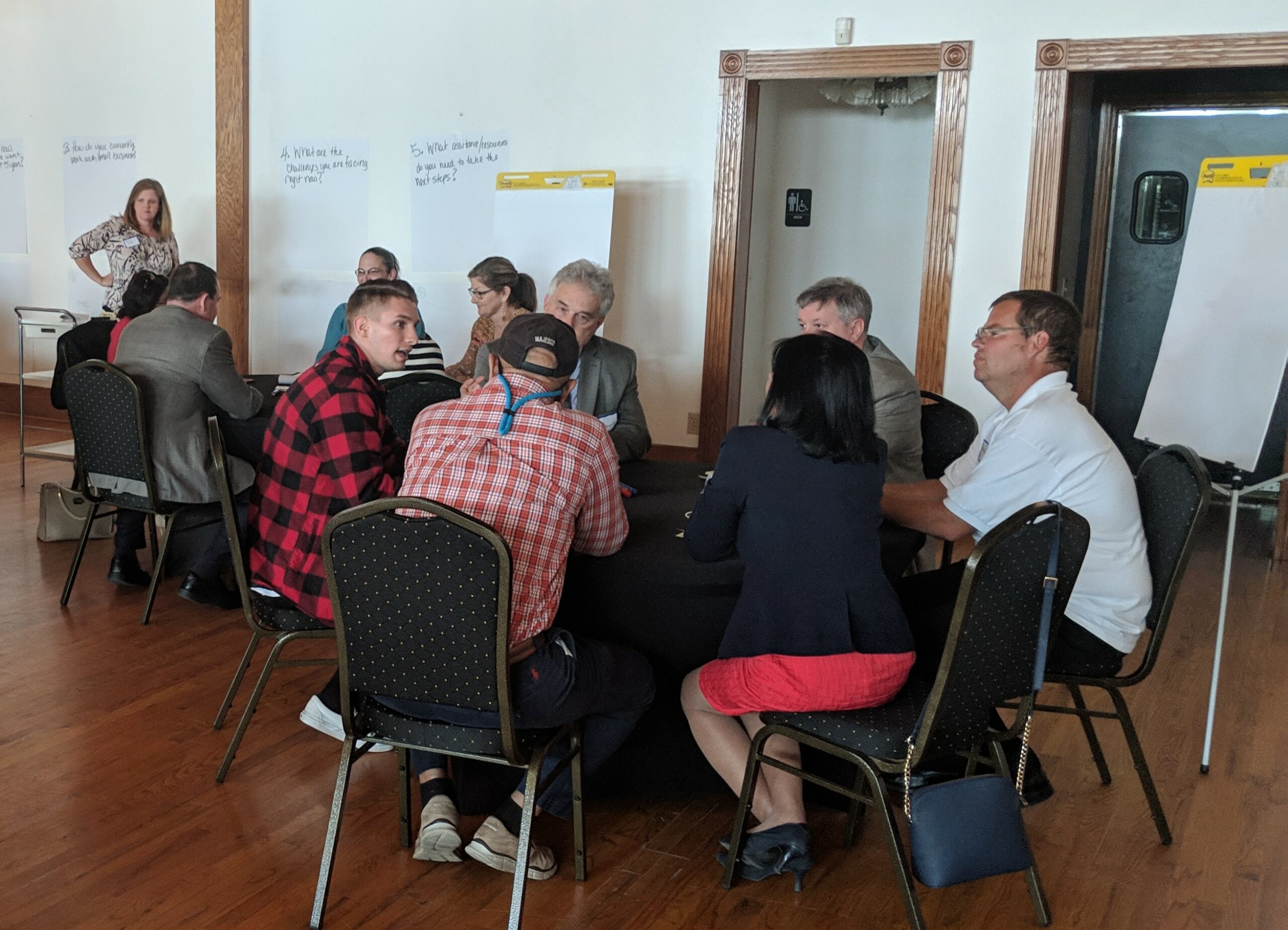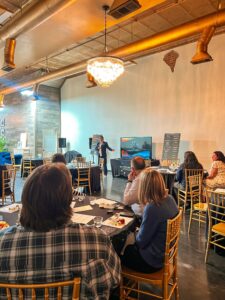
By: Sunnie Dawn Baker
Many of us learned about “ecosystems” when we were in elementary school. We were taught that an ecosystem was an area where living and non-living things interact, or, as the National Geographic Society defines it, “A geographic area where plants, animals, and other organisms, as well as weather and landscapes, work together to form a bubble of life.” One may wonder, if the term ecosystem comes from the natural sciences, what does it have to do with the world of business? Entrepreneurial Ecosystems, or Innovation Ecosystems, actually function similarly to the biological ecosystems that we grew up learning about, except instead of plants and animals, the principal players are businesses, organizations, individuals, and communities that work together to form a thriving and supportive business community.
How did the term “Ecosystem” enter the vocabulary of the business world?
While “ecosystem” was originally coined in 1935 by British botanist Arthur Tansley, the term entered the world of business in 1993. James F. Moore, in his article “Predators and Prey: A New Ecology of Competition,” published in the May-June edition of the Harvard Business Review, wrote, “I suggest that a company be viewed not as a member of a single industry but as a part of a business ecosystem that crosses a variety of industries.”
While Moore was primarily focusing on the “predator and prey” aspects, using a strong ecosystem in order to vanquish the competition in a kill or be killed kind of mentality, today’s current concept has taken more of a collaborative tone, where all parts of the ecosystem exist to work together, strengthen, and build each other up.
One major reason for this change of focus was the Kauffman Foundation. In 2017, they hosted their first ESHIP Summit that was focused on ecosystem building in order to support entrepreneurs and build stronger economies. According to Victor Hwang, Vice President of Entrepreneurship for the Kauffman Foundation, in his introduction to the Entrepreneurial Ecosystem Building Playbook 3.0, it is necessary to build a new professional field specifically for ecosystem builders. He states, “Entrepreneurship drives economies, but the success of entrepreneurs depends on those around them. That’s why we build ecosystems—or communities—for entrepreneurs. A thriving entrepreneurial ecosystem requires more than entrepreneurs…You and your communities make ecosystems work.”
Why is this new view of ecosystem building so important?
According to Jim Eldridge, CEO of the Ada Jobs Foundation, we often think about one company outcompeting another company, but in this view, there is an underlying message that there is room for everybody. He says, “You just have to find your niche and everything you do is additive. And that’s not to say that people aren’t competing in the same markets and trying to chase the same resources, but these entrepreneurs come up with really innovative and clever ways of adapting to change.” And it is the ecosystem that helps support and encourage entrepreneurs in their innovation.
Eldridge also cites the ideas of Hwang, that a successful entrepreneurial ecosystem is more like a rainforest and less like a plantation. The previous model of entrepreneurship, what Moore was discussing in 1993, was more like a plantation. There is a single crop that is produced and everything in the ecosystem is built up around it, making sure that one crop flourishes and grows—the ecosystem works in service of the single crop. However, in the rainforest model, you don’t know what is going to pop out of the soil. You develop a nutrient rich ecosystem that is full of potential to support whatever new creation—in this case a new innovation—that can pop out of it. The ecosystem is not created to support the entrepreneur, but rather the entrepreneur is created because of the supportive ecosystem and the favorable conditions for growth and innovation. As Hwang writes in “Rainforests as a Model for Economic Growth,” published on the Business Ecosystem Alliance website, “Natural rainforests do not predetermine the evolution of new species, but they provide the right setting to foster their serendipitous evolution. The most promising life forms emerge in unpredictable ways from highly fertile environments. Human ecosystems are similar to rainforests. We cannot force specific innovations into existence sustainably, but we can design and shape environments that cause innovation to be born and thrive.”
What are the differences between Rural and Urban Entrepreneurial Ecosystems?
There are many differences between rural and urban environments, and ecosystem building is no exception. Eldridge states, “I think in a rural area, networks are more personal, rather more one on one kinds of relationships with people.” In a rural ecosystem, it is possible that it could span the entire community with everyone involved—attorneys, accountants, graphic designers—and many of these people may serve multiple roles within the broader community.
Molly Pyle, Head of Entrepreneurship for the Center on Rural Innovation, explains the importance of rural ecosystem building as well, saying, “It is so important, especially in rural areas, because it allows for the network effect. Everybody needs to be playing a role and every organization and person is interconnected to build a better future for the community.” While Hwang views a successful entrepreneurial ecosystem like a rainforest,
Pyle explains the ecosystem as a constellation by visualizing the connections between the stars. There are many stars in a constellation, and each star is an individual or an organization. For instance, East Central University could be a star and Pontotoc Technology Center could be a star and the City of Ada could be a star and so could Ada Jobs Foundation. When you zoom in closely, you just see a bright shining star, but when you zoom out you can see the full picture of all the stars interconnected to make a beautiful image that tells a story. It is that interconnectedness of all the individuals, organizations, and businesses that makes an ecosystem.
In terms of economic development, the ecosystem model is important because it creates spaces for many different kinds of business support services. The goal of an economic development organization is to ensure the ecosystem is healthy. Maybe this ecosystem helps ensure that that a startup has access to a local graphic designer that can help design a new logo or that a small business has an opportunity to network with other startups and start meeting with a mentor. The goal of this approach to economic development is to leverage the network effects to create a more connected and active community of startups, services, mentors, and investors.
In order to create a successful entrepreneurial and innovation ecosystem in our community we must realize and embrace the strengths of our connections. No single individual or organization or business exists in a vacuum. We all affect each other; this effect can be negative or positive. By choosing to be supportive of one another, and focus on collaboration, the community can come together to create a beautiful constellation that tells our story or a vibrant rainforest that encourages new growth. We build this ecosystem together and become a stronger community for it.
Written by
Jessika Leatherbury
You may also interested in:
MEET THE STAFF
DANIEL CASTANEDA Daniel Castaneda came to Grow Ada, formerly known as the Ada Jobs Foundation, four years ago. He holds a master’s degree in Regional and City Planning from theKNOWLEDGE IS POWER: LOCAL EXPERT LEADS SMALL BUSINESS NETWORKING WORKSHOP
BY: SUNNIE DAWN BAKER Every month, Grow Ada hosts local Tech Meetups to help build and encourage our tech community. In some cases, there are speakers who give presentations on
BUILDING ADA'S FUTURE: INDUSTRY, INNOVATION, AND ENTREPRENEURSHIP
BY: SUNNIE DAWN BAKER As the local economic development organization, Grow Ada, formerly known as the Ada Jobs Foundation, is well positioned to facilitate in our community’s continued success. While
After the Storm: How Ada United to Help Main Street Rebuild
By: Sunnie Dawn Baker In the early hours of March 4th, a tornado flung the citizens of Ada, Oklahoma into chaos as the wind howled and the rain poured, the
Bridging the Digital Divide: Grow Ada's Role in Advancing Rural Tech Skills
By: Sunnie Dawn Baker Rural communities face many challenges, especially when it comes to digital skilling and technological workforce development. One way that Grow Ada has been working to overcome
Closing the STEM Gap: ECU’s Innovative Program for Teachers and Students
By: Sunnie Dawn Baker STEM (Science Technology Engineering and Math) is increasingly important in today’s world. Technology touches nearly every aspect of our lives and will continue to expand its
Adapt and Overcome: Allison Poe’s Recipe for Resilience and Growth
By: Sunnie Dawn Baker Allison Poe has always followed her feet. She waits for the signs to appear and, once she recognizes them, she travels that path, and has never
From Pitch to Progress: ECU's Glass Recycling Program Turns Waste into Opportunity
By: Sunnie Dawn Baker In 2018, Dr. Christine Pappas competed in Ada Jobs Foundation’s Big Pitch Competition by promoting grinding glass bottles into sand. She won the Big Pitch that
The Importance of Customer Discovery: Know Your Audience and Know Your Market
By: Sunnie Dawn Baker Entrepreneurs and small business owners must consider many factors to achieve success, with their target market being one of the most crucial. Sometimes, when people are